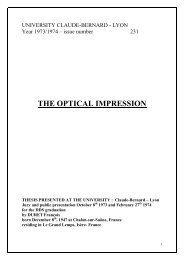english version(pg40to78) - Pr. François Duret
english version(pg40to78) - Pr. François Duret
english version(pg40to78) - Pr. François Duret
You also want an ePaper? Increase the reach of your titles
YUMPU automatically turns print PDFs into web optimized ePapers that Google loves.
F <strong>Duret</strong> and Coll. <strong>Pr</strong>incipes de fonctionnement et applications techniques de l’empreinte optique dans l’exercice de cabinet<br />
(traduction Anglaise)<br />
Page 105<br />
We estimate that the dental biomaterial problem must totally rethought.<br />
To treat our patients, we are almost always led to create a<br />
loss in substances following the removal of responsible pathologic<br />
tissues. If this loss of substance affects a tissue without repairing<br />
powers, we would use a heterogeneous material whose properties will<br />
be identical to those of the destroyed tissue. The fixation of this<br />
reconstituted volume would have to happen without the rest of the<br />
organ suffering any damage.<br />
All of this seems so evident…! But the most commonly used<br />
biomaterial – silver amalgam – shows a thermal conductivity<br />
coefficient 50 times higher than the dentin it pretends to replace! Let’s<br />
not talk about the optical properties…<br />
What is our philosophy?<br />
We estimate that to each type of substance loss corresponds a<br />
biomaterial whose properties will be clearly noted in a specification’s<br />
book. Thus defined, this material will be manufactured industrially, its<br />
properties verified carefully and it will exist in a state of stable pre<br />
shapes on which we will “manufacture” our prosthetic pieces. This<br />
type of action is new: for the first time, the clinical requests won’t<br />
have to accept the disadvantages of a material just because it<br />
possesses an essential quality to fill the loss of substance to treat.<br />
For sure these adequate “bioproperties”, mixed with the justness and<br />
precision of the Computer Assisted Manufacturing will lead to tissue<br />
savings and to a more durable treatment. Let’s think for a while about<br />
the cutting excesses that we authorise just to fill one or more<br />
disadvantages of the material we have chosen to treat the substance<br />
loss…?! The thing is even worse since is ahs become a real reflex of<br />
conscientious practioner: it is not our fault, we were all “born” under<br />
the rules of volume production by moulding and lost wax. But we then<br />
had nothing else, we had to make do.<br />
Today, material science, thanks to several “strong” implusions<br />
(aeronautics, electronics, chemical industries…) had practically<br />
unlimited means so long as it is clearly defined our needs.<br />
Les Cahiers de <strong>Pr</strong>othèse (50) pp 73 – 110, 1985



